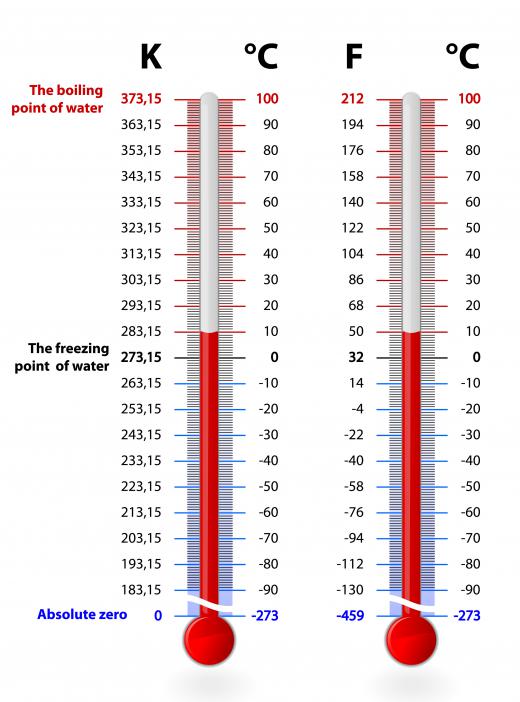What is the Lowest Possible Temperature?
 Michael Anissimov
Michael Anissimov
The lowest possible temperature, or absolute zero as it is called, is -459.67°F (-273.15°C). It is also called 0 kelvin, a scale with increments equivalent to degrees of Celsius, but which uses absolute zero rather than water's freezing point as its starting point. This is the point at which all atomic motion ceases.
The above definition may be incomplete, however, as an atom is itself an entity with complex internal structure. To achieve the lowest possible temperature, or true absolute zero, not only must atomic motion stop, but all of the atom's internal components would need to stop as well. Electrons would need to stop orbiting their respective atomic nuclei, the neutrons and protons in the nuclei would need to stop pulling each other around with their internal forces, the quarks, and any underlying substructure must cease all activity. Due to quantum mechanical effects, this is impossible. Therefore, a more precise definition applies to collections of matter from which no further thermal energy may be extracted, i.e., another collection of atoms brought into contact with the sample will always transfer energy to it, never the reverse.
Like the efficiency of a system, the velocity of a particle, or the maximum possible temperature, absolute zero is actually a theoretical quantity that can only be approached, but likely never achieved.

Temperatures near absolute zero have been achieved with the techniques of laser cooling and magnetic evaporative cooling. In laser cooling, fast-moving atoms are jostled with photons until they slow down to 1/10,000th of a degree kelvin. In magnetic evaporative cooling, the remaining atoms are held in loosely place by a magnetic field, and the more energetic atoms eventually escape, leaving behind the slowest remainders. Using these techniques, temperatures as low as 250 picokelvins (pK) have been achieved. Matter this cold can behave in bizarre ways, forming structures called Bose-Einstein condensates, which demonstrate a property called superfluidity, or the flowing of atoms without viscosity.
AS FEATURED ON:
AS FEATURED ON:












Discussion Comments
Boomerang Nebula achieved 1K to become the coldest natural object known to man.
I like to use articles like this to prove just how wrong my children can be.
I do wonder, would absolute zero be present when the universe starts to contract? That would be sick, total atomic motion ceases. And wouldn't freezing you kill you anyway?
CancerKicker- Yeah I read further into it after you responded and found that people not only freeze themselves but also freeze their pets. And that they will just totally let you thaw out and bury you if they don't receive your payment.
That's not for me at all. When I'm gone I'm gone. My wife can use my life insurance check to do whatever she wants. I read people will leave their money to these companies!
GameHunter00- No freezing the dead is not science fiction; even though the process has never proven successful it seems people are willing to take that risk for a lot of money. Long-term cryopreservation works by cooling the just deceased person to near 77.15 Kelvin.
Then as long as the payments are made and the company remains in business, they preserve the body until hopefully someday a way to unfreeze the body and repair the tissue damage is discovered. They are 100% unsure what condition the body and mind would be after thawing out from cryonics.
Is it true some people are frozen and stored somewhere only to be thawed way in the future? Has it been proven they can be brought back to life or are they frozen with no guarantee to be awoken? I just heard of it and wasn’t sure if it’s real or science fiction.
stare31- That is too funny. I was for certain absolute zero was at the polar ice caps or even on another planet. But to find out achieving absolute zero is about as impossible as counting to infinity is crazy. I didn’t know it was that hard to cease thermal energy, but I guess I’m comparing it to what a human can stand versus life in its simplest form.
I swear I experienced the lowest possible temperature when I visited East Slovakia in the winter! ;)
Post your comments